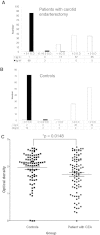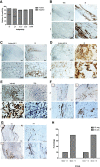High prevalence of human cytomegalovirus in carotid atherosclerotic plaques obtained from Russian patients undergoing carotid endarterectomy
- PMID: 24229441
- PMCID: PMC4177206
- DOI: 10.1186/2042-4280-4-3
High prevalence of human cytomegalovirus in carotid atherosclerotic plaques obtained from Russian patients undergoing carotid endarterectomy
Abstract
Background: Human cytomegalovirus (HCMV) infection is associated with cardiovascular disease (CVD) but the role of this virus in CVD progression remains unclear. We aimed to examine the HCMV serostatus in Russian patients (n = 90) who had undergone carotid endarterectomy (CEA) and controls (n = 82) as well as to determine the prevalence of HCMV immediate early (IE) and late (LA) antigens in carotid atherosclerotic plaques obtained from 89 patients. In addition, we sought to determine whether HCMV infection was associated with inflammatory activity in the plaque by quantifying infiltrating CD3 and CD68 positive cells and 5-LO immunoreactivity.
Methods: HCMV serology was assessed with ELISA and immunohistochemistry staining was performed to detect HCMV antigens, CD3, CD68 and 5-LO reactivity. The Fisher's exact test was used to compare i) seroprevalence of HCMV IgG between patients and controls and ii) HCMV-positive or -negative to that of CD3, CD68 and 5-LO immunoreactive cells in plaque samples. The student-t test was performed to connote the significance level of mean optical density between patients and controls.
Results: The seroprevalence for HCMV IgG was high in both patients and controls (99% and 98%, respectively). Controls had significantly higher IgG titers for HCMV compared with patients (p = 0.0148). Strikingly, we found a high prevalence of HCMV antigens in atherosclerotic plaques; 57/89 (64%) and 47/87 (54%) were HCMV IE and LA positive, respectively. Most plaques had rather low HCMV reactivity with distinct areas of HCMV-positive cells mainly detected in shoulder regions of the plaques, but also in the area adjacent to the necrotic core and fibrous cap. In plaques, the cellular targets for HCMV infection appeared to be mainly macrophages/foam cells and smooth muscle cells. HCMV-positive plaques trended to be associated with increased numbers of CD68 positive macrophages and CD3 positive T cells, while 5-LO reactivity was high in both HCMV-positive and HCMV-negative plaques.
Conclusions: In Russian patients undergoing CEA, HCMV proteins are abundantly expressed in carotid plaques and may contribute to the inflammatory response in plaques via enhanced infiltration of CD68 and CD3 cells.
Figures



Similar articles
-
The contribution of inducible nitric oxide and cytomegalovirus to the stability of complex carotid plaque.J Vasc Surg. 1999 Jul;30(1):36-49; discussion 50. doi: 10.1016/s0741-5214(99)70174-6. J Vasc Surg. 1999. PMID: 10394152
-
Expansion of the NKG2C+ natural killer-cell subset is associated with high-risk carotid atherosclerotic plaques in seropositive patients for human cytomegalovirus.Arterioscler Thromb Vasc Biol. 2013 Nov;33(11):2653-9. doi: 10.1161/ATVBAHA.113.302163. Epub 2013 Aug 22. Arterioscler Thromb Vasc Biol. 2013. PMID: 23968979
-
Increased vascularization of shoulder regions of carotid atherosclerotic plaques from patients with diabetes.J Vasc Surg. 2011 Nov;54(5):1324-1331.e5. doi: 10.1016/j.jvs.2011.04.061. Epub 2011 Jul 20. J Vasc Surg. 2011. PMID: 21764240
-
Age-related changes in plaque composition: a study in patients suffering from carotid artery stenosis.Cardiovasc Pathol. 2005 May-Jun;14(3):126-34. doi: 10.1016/j.carpath.2005.03.002. Cardiovasc Pathol. 2005. PMID: 15914297
-
Expanding expression of the 5-lipoxygenase/leukotriene B4 pathway in atherosclerotic lesions of diabetic patients promotes plaque instability.Biochem Biophys Res Commun. 2007 Nov 9;363(1):30-6. doi: 10.1016/j.bbrc.2007.08.134. Epub 2007 Aug 31. Biochem Biophys Res Commun. 2007. PMID: 17825794
Cited by
-
High anti-human cytomegalovirus antibody levels are associated with the progression of essential hypertension and target organ damage in Han Chinese population.PLoS One. 2017 Aug 24;12(8):e0181440. doi: 10.1371/journal.pone.0181440. eCollection 2017. PLoS One. 2017. PMID: 28837559 Free PMC article.
-
Human cytomegalovirus and neonatal infection.Curr Res Microb Sci. 2024 Jun 24;7:100257. doi: 10.1016/j.crmicr.2024.100257. eCollection 2024. Curr Res Microb Sci. 2024. PMID: 39070527 Free PMC article. Review.
-
Using NMR in saliva to identify possible biomarkers of glioblastoma and chronic periodontitis.PLoS One. 2018 Feb 6;13(2):e0188710. doi: 10.1371/journal.pone.0188710. eCollection 2018. PLoS One. 2018. PMID: 29408884 Free PMC article.
-
Limited effect of duration of CMV infection on adaptive immunity and frailty: insights from a 27-year-long longitudinal study.Clin Transl Immunology. 2020 Oct 14;9(10):e1193. doi: 10.1002/cti2.1193. eCollection 2020. Clin Transl Immunology. 2020. PMID: 33133599 Free PMC article.
-
How does cytomegalovirus factor into diseases of aging and vaccine responses, and by what mechanisms?Geroscience. 2017 Jun;39(3):261-271. doi: 10.1007/s11357-017-9983-9. Epub 2017 Jun 18. Geroscience. 2017. PMID: 28624868 Free PMC article.
References
-
- Mocarski ES, Courcelle CT. In: Fields Virology, Volume 2. 4. Knipe D, Howley PM, editor. Philadelphia: Lippincott Williams and Wilkins; 2001. Cytomegaloviruses and their replication; pp. 2629–2673.
-
- Cannon MJ, Schmid DS, Hyde TB. Review of cytomegalovirus seroprevalence and demographic characteristics associated with infection. Rev Med Virol. 2010;20(4):202–213. - PubMed
-
- Rosenfeld ME, Campbell LA. Pathogens and atherosclerosis: update on the potential contribution of multiple infectious organisms to the pathogenesis of atherosclerosis. Thromb Haemost. 2011;106(5):858–867. - PubMed
-
- Epstein SE, Zhou YF, Zhu J. Infection and atherosclerosis: emerging mechanistic paradigms. Circulation. 1999;100(4):e20–e28. - PubMed
LinkOut - more resources
Full Text Sources
Other Literature Sources
Miscellaneous

